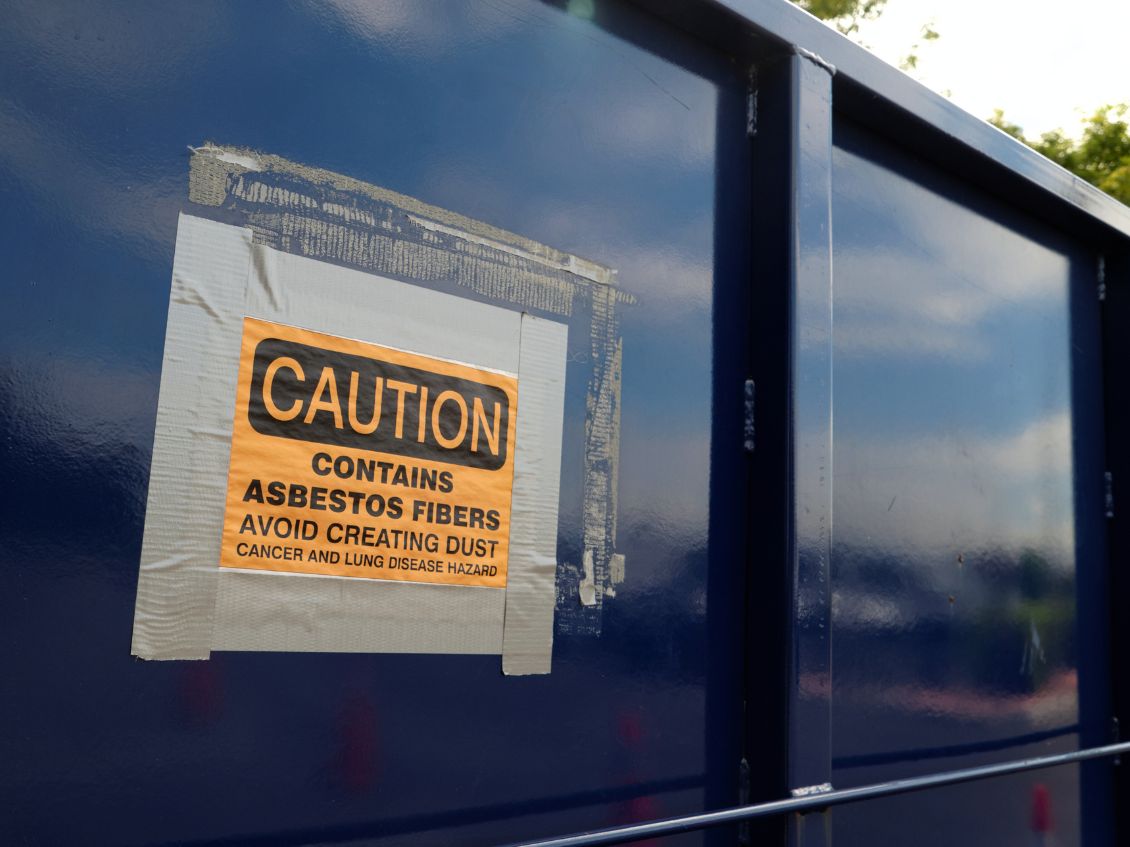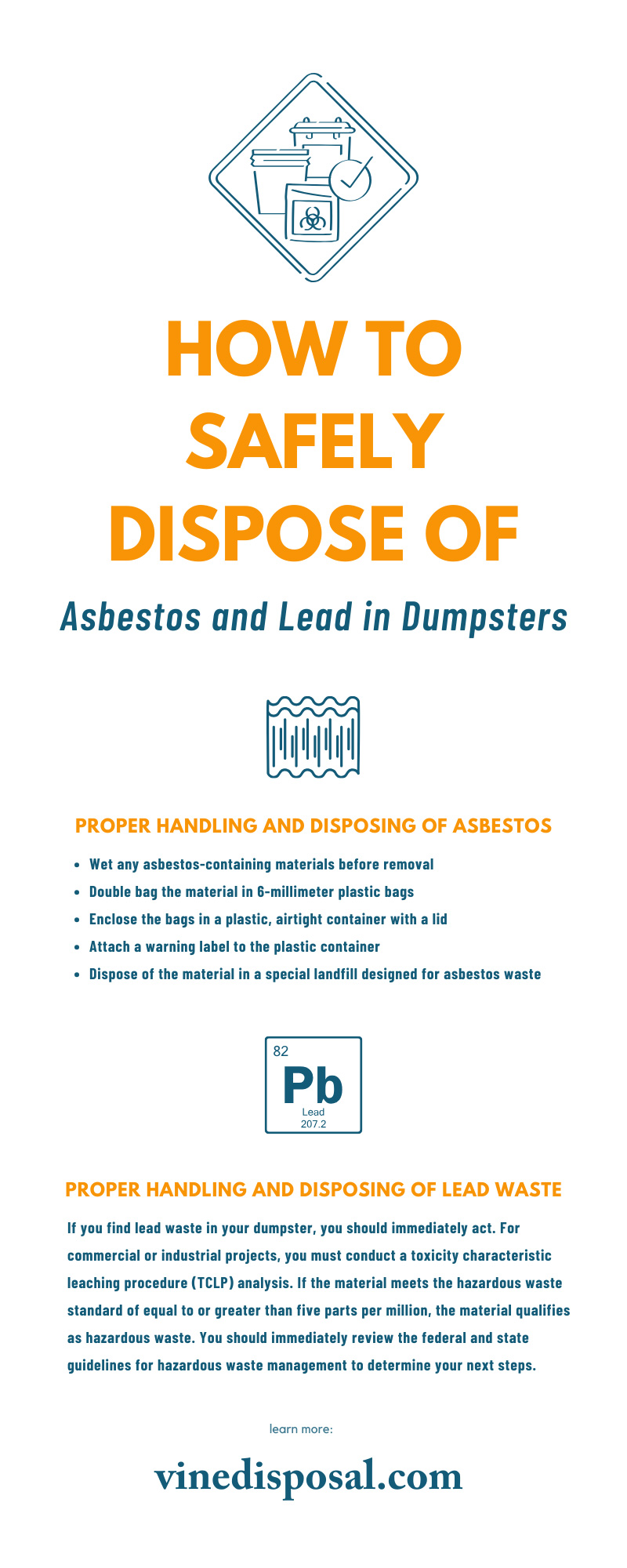
Many homes and buildings built before 1980 could contain asbestos and lead. If you manage a construction site, you should always remain vigilant and look for signs of harmful substances, such as asbestos and lead. A failure to properly handle asbestos or materials containing lead could jeopardize yourself, your workmates, and the public. Here are some helpful tips on how to safely dispose of asbestos and lead in dumpsters.
Why Should You Remove Hazardous Waste Materials From the Jobsite?
If you value your position as a construction manager, you must do everything you can to limit exposure to asbestos and lead on the jobsite. You should implement administrative and exposure control measures to ensure your workers remain safe and productive at work. You should safely remove hazardous waste materials, such as asbestos and lead, for the following reasons:
- You could compromise the health of your employees, increasing the medical and wage costs for your jobsite.
- You could damage valuable relationships with clients who prioritize a safe jobsite environment.
- You could experience costly job shutdowns and significant fines from state and federal agencies.
Proper Handling and Disposing of Asbestos
You must take immediate action if you find asbestos-containing materials in your dumpster. You should immediately contact a licensed asbestos consultant who will survey the waste materials. Second, you should have any asbestos waste removed from the jobsite by a qualified asbestos contractor or abatement specialist.
If you decide to handle the asbestos removal yourself, you must adhere to the guidelines provided by state and federal law. In addition to the Environmental Protection Agency (EPA), state agencies will have strict instructions regarding removing asbestos-containing material. Here’s a snapshot of the asbestos containment and removal process:
- Wet any asbestos-containing materials before removal
- Double bag the material in 6-millimeter plastic bags
- Enclose the bags in a plastic, airtight container with a lid
- Attach a warning label to the plastic container
- Dispose of the material in a special landfill designed for asbestos waste
Proper Handling and Disposing of Lead Waste
If you find lead waste in your dumpster, you should immediately act. For commercial or industrial projects, you must conduct a toxicity characteristic leaching procedure (TCLP) analysis. If the material meets the hazardous waste standard of equal to or greater than five parts per million, the material qualifies as hazardous waste. You should immediately review the federal and state guidelines for hazardous waste management to determine your next steps.
For example, a Georgia construction crew must follow their state’s rules for hazardous waste management. If the quantity of lead-based waste exceeds 220 pounds or more, your team must follow the procedures listed under the Georgia Rules of Hazardous Waste Management, Chapter 391-3-11.
If the quantity of waste is less than 220 pounds, you may have the option of disposing of the material in a municipal solid waste (MSW) or construction and demolition (C&D) landfill. If you need help finding the specific procedures for your jobsite, we recommend contacting a hazardous waste specialist to help you navigate the removal process.
Dangers of Asbestos Exposure
As a construction manager, protecting the health and safety of your workforce and anyone who visits the jobsite is essential. You should remove any hazardous materials as quickly and efficiently as possible. If asbestos fibers become activated, your team could inhale lingering asbestos particles. Here are some of the most dangerous health risks linked to asbestos exposure:
- Asbestosis (scarring in the lungs)
- Lung cancer
- Non-cancerous lung conditions
- Respiratory ailments
- Decreased immune system
Dangers of Lead Exposure
You should also avoid and eliminate lead exposure on the jobsite. If you find lead-containing materials in your Snellville dumpster rental, you should conduct a lead risk assessment to determine your next steps. Lead exposure can cause developmental issues in young children and impact the health of older adults. Here are some of the dangers linked to lead exposure in the workplace:
- Increased risk of high blood pressure
- Cardiovascular problems
- Kidney damage
- Infertility
- Brain and nervous system damage
How To Identify Asbestos Material for Removal
Along with learning how to safely dispose of asbestos and lead in dumpsters, you must learn how to identify hazardous material for removal. Unfortunately, many health professionals refer to asbestos as the silent killer. Asbestos fibers hide easily in building materials, making them difficult to find.
You will find it nearly impossible to see asbestos particles moving through the air. The best way to identify asbestos material for removal is to conduct an asbestos survey. An asbestos surveyor will gather key information about the construction zone to pinpoint which materials workers have used.
They will use this information to pinpoint potential target areas for asbestos. If the surveyor identifies the presence of asbestos, you should work on a containment/removal plan to protect the health of yourself and your workers. Ideally, you should begin the containment process as soon as you discover the presence of asbestos.
How To Identify Lead Material for Removal
You can find lead in many construction materials, including paints, lead mortars, and base metals. Certain actions like sanding, welding, and torch cutting can create high airborne exposure levels. Here are the best ways to identify lead material for removal:
- Know the age of the building and any materials or coatings that could contain lead
- Communicate with the property owner for relevant information
- Review the list of materials in use on the jobsite
- Take samples and have them tested for lead content
Find the Best Dumpster Rental for Your Construction Project
While hazardous waste material requires a unique removal process, you can throw most construction waste directly into a dumpster. If you are looking for the best dumpster rental for your construction project, look no further than Vine Disposal.
We provide construction jobsites with durable, high-quality dumpsters to help you eliminate any debris and unwanted material. We have a range of dumpster sizes that will meet the size and scope of your commercial project.
Our 20-to-40-yard construction dumpster rentals are the perfect size for larger commercial renovations. Please check out our website for more information about dumpster rentals in Snellville. Feel free to email or call us if you have any questions or need further clarification of our services.

